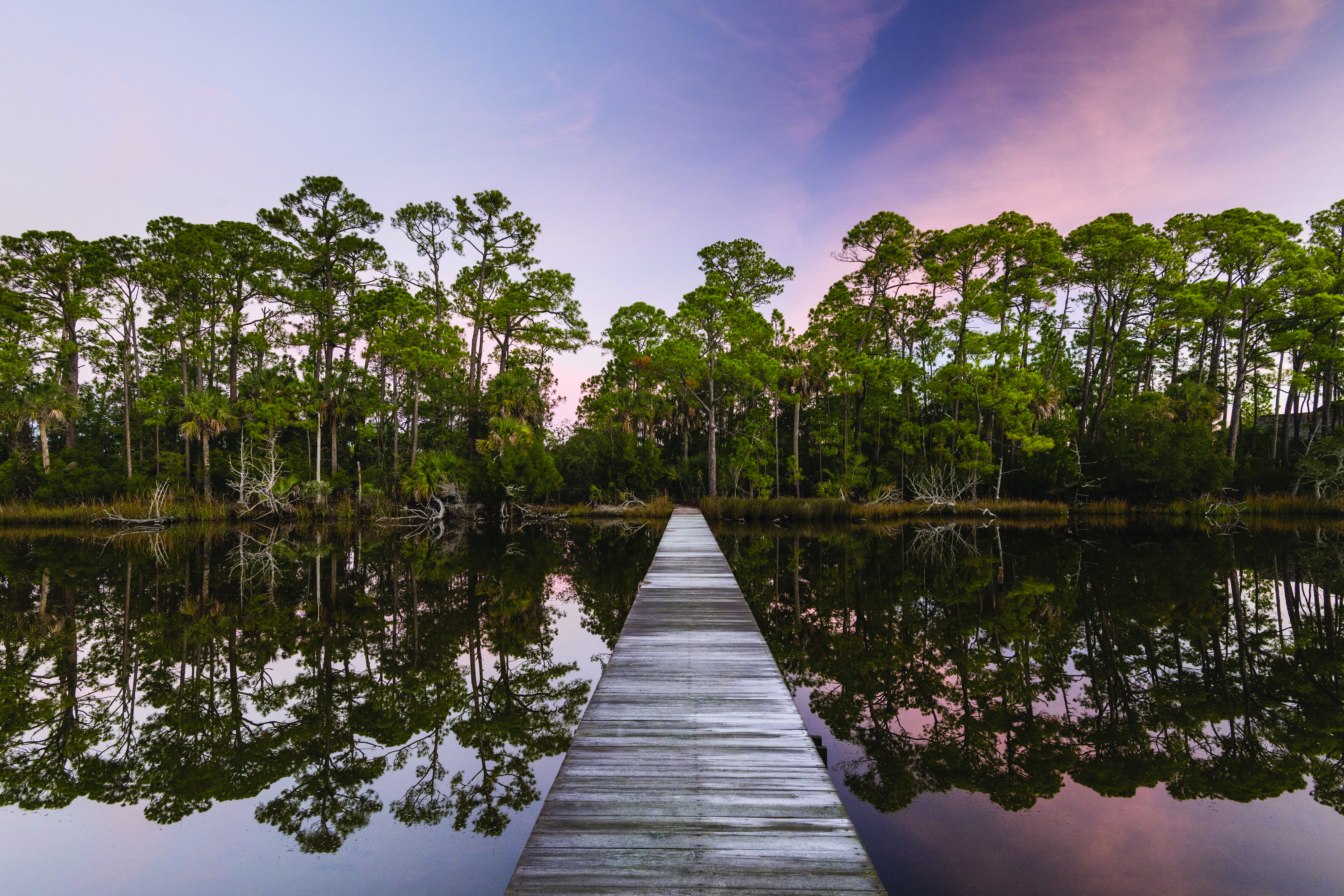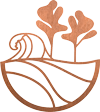Nature Haven
The first visit to Kiawah Island is always memorable. The sprawling grand oaks, marsh as far as the eye can see, the serene beaches—each facet emits a mystique that beckons the viewer. I like to think that I have internalized this landscape. In my four years on Kiawah Island, my admiration and intrigue for this environment has not waned. In tradition with other conservationists, I hope to inspire others to see these habitats from a similar perspective and delight in their intrinsic beauty.
Together, five crucial habitats contribute to the health of our barrier island ecosystem. Over the past few years, the Kiawah Island Conservancy has initiated research on the relationship between these habitats and the wildlife that call them home. The culmination of this work is the Ecological Health Initiative, an effort to research and monitor the vegetative cover, water levels, and species abundance of these habitats.
Shrub Thicket
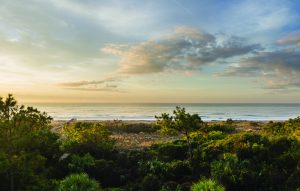
Along the edges of the maritime forests is a transitional zone dominated by dense, shrubby vegetation and ground covers. These habitats, referred to generally as shrub thickets, come in two types: maritime shrub thicket and salt shrub thicket.
Maritime shrub thickets form between the dunes and maritime forest. Live oaks, pines, wax myrtles, and red cedars in these areas are wind pruned by salty air coming off the ocean, producing a gently sloping hedge along the beach. Salt shrub thickets form between the salt marsh and the maritime forest, consisting of low-growing trees, shrubs, and a variety of dense ground covers.
The vegetation in these thickets make them a prime location for resident and migratory songbirds, providing abundant nesting areas, protection from predators, and easy access to fruiting plants. Migratory songbirds traveling the Atlantic Flyway in the fall pass through Kiawah to refuel before continuing onto their southerly destinations. Shrub thickets are also critical habitats for the island’s elusive bobcat population. The dense vegetation provides excellent cover for nighttime travel. During the mating season, it also provides prime habitat for denning bobcats.
In addition to the benefits to wildlife, shrub thickets protect the interior maritime forest from salt spray and decrease the impacts of winds, waves, and storm surge. They also serve to stabilize soils along the edge of the maritime forest.
Maritime Forest
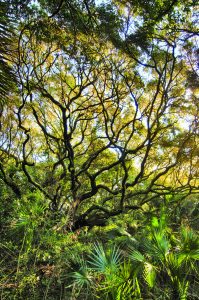
Over the course of millennia, barrier islands gradually accrete land seaward. As the dunes continue to march forward, the land behind begins to stabilize and recruit plant species. This area eventually develops into mature maritime forest habitat with layered canopies, understory trees, shrubs, and ground covers.
Many species of mammals and reptiles call these forests home. Shrubs and ground covers provide a screen for travel, feeding, nesting, and resting for migratory birds. Dead trees are an important source of habitat. Standing “snags” often provide nesting sites for woodpeckers and small mammals. Once these trees fall, the trunks and overturned root systems provide denning sites for bobcats. Openings in the canopy also encourage new growth, giving new life a chance to appear in the forest.
An intact maritime forest regulates the environment, especially in regards to water. Forests act like sponges, soaking up water and slowly releasing it over time. Forest vegetation slows the fall of rainwater before it finds the forest floor and percolates through the soil. Eventually, rain collects in a shallow groundwater aquifer two to four feet below the soil surface. Groundwater gradually drains through the soil and into nearby water bodies over time. This natural process reduces the amount of stormwater runoff and promotes nutrient cycling, which helps protect water quality in the surrounding waterways.
Forests also provide protection from severe weather. The canopy trees and shrubs reduce wind exposure to buildings, and root systems keep soil from eroding. Tall trees adjacent to the beach also capture aerosol salt spray caused by oceanic winds, which prevents impacts to infrastructure and other forest vegetation further inland.
Beaches and Dunes
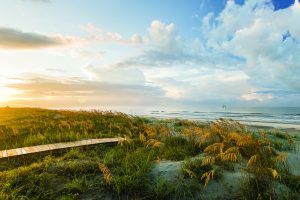
Wide, white sand beaches stretch from the mouths of the Kiawah and Stono Rivers. These beaches are bordered on the landward side by a rolling dune system. Together, the beach and dunes provide an extraordinary habitat for a variety of wildlife throughout the year.
From March to September, seaward dunes serve as nesting sites for sea turtles. Hundreds of nests are laid each season, with an average of one hundred eggs per nest. Monitoring and management of these nests has been a priority for Kiawah Island for decades. Kiawah’s beaches also provide feeding, nesting, and resting areas for resident and migratory shorebirds. Oystercatcher and least tern nests are commonly found on the eastern end of Kiawah, adjacent to The Ocean Course. The intertidal beach, between low and high tide, is considered a highly important region. Shorebirds use these areas to sift for food. Scientists recently highlighted the importance of Kiawah’s intertidal beaches for migratory red knots. Every winter, red knots travel from the Canadian Arctic to breeding grounds as far south as Tierra del Fuego. To fuel this nonstop flight, red knots briefly visit the beaches on Kiawah to feed before continuing their journey south.
Likewise, the beaches and dunes contain a wide variety of plants and invertebrates, which provide fuel for the ecosystem. Pioneer plants in this habitat brave hot, salty, and windy conditions to become established and stabilize the sand against erosion. Kiawah Island’s dune system is one of the most geologically stable along the South Carolina coast. These habitats protect Kiawah Island from the impacts of extreme tides and storm surges throughout the year.
Salt Marsh
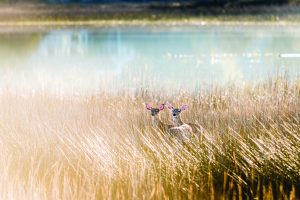
Nothing is more symbolic of the South Carolina Lowcountry than our great expanse of tidal salt marsh. While beautiful and strangely mysterious, they are also widely considered one of the most biologically productive and diverse ecosystems in the world. The salt marsh is fueled by a thriving plant community that supports fish and wildlife.
Smooth cordgrass dominates lower elevations of the marsh. These areas are perpetually influenced by twice daily tidal inundation. Plants become more diverse in slightly higher elevations of the marsh, providing optimal areas for the growth of saltwort, glasswort, and Carolina sea lavender, among others. As these plants die back over the winter, they break down to produce organic matter, or detritus. This process provides fuel for invertebrates and filter feeders that are preyed upon by estuarine fish and wildlife.
Wading birds can be found throughout the year in the marsh, scouring the creek banks for food and nesting in nearby trees. The bright white plumages of egrets and herons provide a stark contrast to lush vegetation. Diamondback terrapins also call marshes home, often nesting along the marsh edge and feeding on aquatic invertebrates. They are one of the main predators of periwinkle snails and are responsible for keeping their populations in check. A variety of mammals can be found here as well. Deer, opossums, raccoons, and bobcats use these areas to travel across the landscape to marsh hummocks. Marshes are also critical habitats for mink, which use wrack as floating platforms to travel the creeks and rivers.
Marshes also provide protection to upland areas by reducing wave action and buffering storm surges. They also support intertidal oysters, which are an essential component within the marsh. Oysters provide food for wildlife and nursery areas for fish populations, and their function as a filter feeder also improves water quality.
Pond
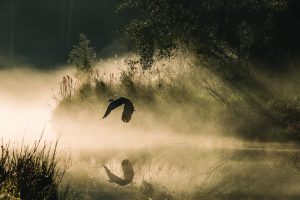
A series of interconnected ponds can be found throughout the island upland. These ponds are a crucial drainage system for the island, managing stormwater runoff. An influx of tidal saltwater mixes with fresh stormwater and groundwater to create brackish water. The salinity varies from pond to pond, but it provides unique opportunities for a variety of fish and wildlife species. As the surface water moves through the system, the biodiverse species in the pond help to improve water quality before being released into the marsh. They also provide a sneak peek into another source of water beneath our feet: the freshwater aquifer found just below the surface. Pond levels generally reflect the groundwater level, often lying two to three feet below the soil surface in most areas of the island.
Reptiles and amphibians are abundant throughout the pond system. A common presence is the American alligator, often seen floating near the surface or sunbathing on the banks alongside yellow-bellied sliders and the bravest of wading birds. Frogs and toads become reinvigorated after rain events, making their presence known through croaking songs. The calm pond waters are also a welcome invitation to the resident wading birds and migratory waterfowl throughout the year. Reedy edges are wonderful areas for wading birds to sift for food and to nest in the overhanging vegetation. Watch for the migratory hooded merganser, easily spotted in the distance by the contrasting colors of their white-and-black crest and piercing yellow eyes.
Story by Lee Bundrick
Photography by Patrick O’Brien




